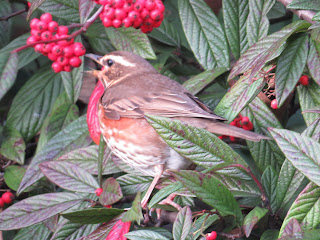 |
| Chinese Water Deer |
It was a blustery day at Strumpshaw today. I arrived early this morning and spent just over an hour inside Fen Hide before I had to start my shift. I watched 2 Chinese water deer, a heron and a group of mallards try to cope with the windy conditions the best they could, while marsh harriers were making the most of the strong gusts and looked as if they were playing in it for fun. For me inside the hide, however, it was not so fun. To see out of the hide, you need to lift up a wooden flap and lock it into place with a levered latch. But it appeared I had not connected it within the latch properly and while I was watching the wildlife and talking to one of my regulars, a sudden blast of wind shook the hide and caused the latch to release the wooden flap onto my head. Ouch! Then, several minutes later, my cap was blown off my head! It was just not my day!
 |
| Grey Heron |
 |
| Marsh Harrier |
 |
| Ben measuring the salinity levels in the water |
Back at Reception Hide, the weather did not improve. In fact it got worse. The wind got stronger and stronger and there was even a short shower at one point this morning. The stormy conditions meant that there weren't exactly loads to see. There was a mixture of ducks out on the broad consisting mainly of mallards, gadwall, teal, coot and the odd shoveler, while marsh harriers continue to wind surf above the reed beds. Closer to the hide, I manage to spot a common snipe probing the reedy stubbled edge of a small channel. Ben, one of the Strumpshaw wardens, then went out in front of the hide to do a salinity measurement in the water and while doing so he spooked a jack snipe from its hiding spot. I also saw a kingfisher and a kestrel this morning, both making brief flyovers as if to escape the howling winds.
 |
| Common Snipe |
 |
| Cormorant |

 |
| Cobber the Black Swan |
 |
| Pheasant |
 |
| Marsh Harrier |
 |
| Matt cutting an Ash Tree down |

As you may remember from a previous post of mine from last month, ash dieback disease has been discovered at the reserve. So far it has only been found on the ash trees by the car park. This is a devastating tree disease and has killed thousands of ash trees across Europe and the only way to slow it from spreading is to cut the diseased trees down. So today, Matt, one of the other wardens managing the reserve, geared himself up and went up a tree, cutting it down piece by piece. This won't exactly eradicate or stop ash dieback from spreading completely as there is no known cure for it. Let's just hope the rest of Strumpshaw's ash trees can survive for at least another year, otherwise we may lose this species forever at the reserve.
 |
| Redwing |
Back at Norwich, I decided to walk home and as it was along the way, I went in search of waxwings around the Anglia Square shopping centre. A flock of them had been reported here in last few days, but the directions to their whereabouts was rather vague. The message I got was that there were 11 waxwings near Anglia Square. Where exactly is 'near'? I've now found out that they were at Edward Street, but at the time, the only place I could think of that was 'near' was a berry-laden tree on the corner of St Augustine's Street. No waxwings, but I did see some blackbirds and redwings gorging on the berries. I also saw a peregrine sitting on the side of Norwich Cathedral's spire this afternoon.
 |
| Blackbird |
 |
| Peregrine |









 As you may remember from a previous post of mine from last month, ash dieback disease has been discovered at the reserve. So far it has only been found on the ash trees by the car park. This is a devastating tree disease and has killed thousands of ash trees across Europe and the only way to slow it from spreading is to cut the diseased trees down. So today, Matt, one of the other wardens managing the reserve, geared himself up and went up a tree, cutting it down piece by piece. This won't exactly eradicate or stop ash dieback from spreading completely as there is no known cure for it. Let's just hope the rest of Strumpshaw's ash trees can survive for at least another year, otherwise we may lose this species forever at the reserve.
As you may remember from a previous post of mine from last month, ash dieback disease has been discovered at the reserve. So far it has only been found on the ash trees by the car park. This is a devastating tree disease and has killed thousands of ash trees across Europe and the only way to slow it from spreading is to cut the diseased trees down. So today, Matt, one of the other wardens managing the reserve, geared himself up and went up a tree, cutting it down piece by piece. This won't exactly eradicate or stop ash dieback from spreading completely as there is no known cure for it. Let's just hope the rest of Strumpshaw's ash trees can survive for at least another year, otherwise we may lose this species forever at the reserve.



























No comments:
Post a Comment